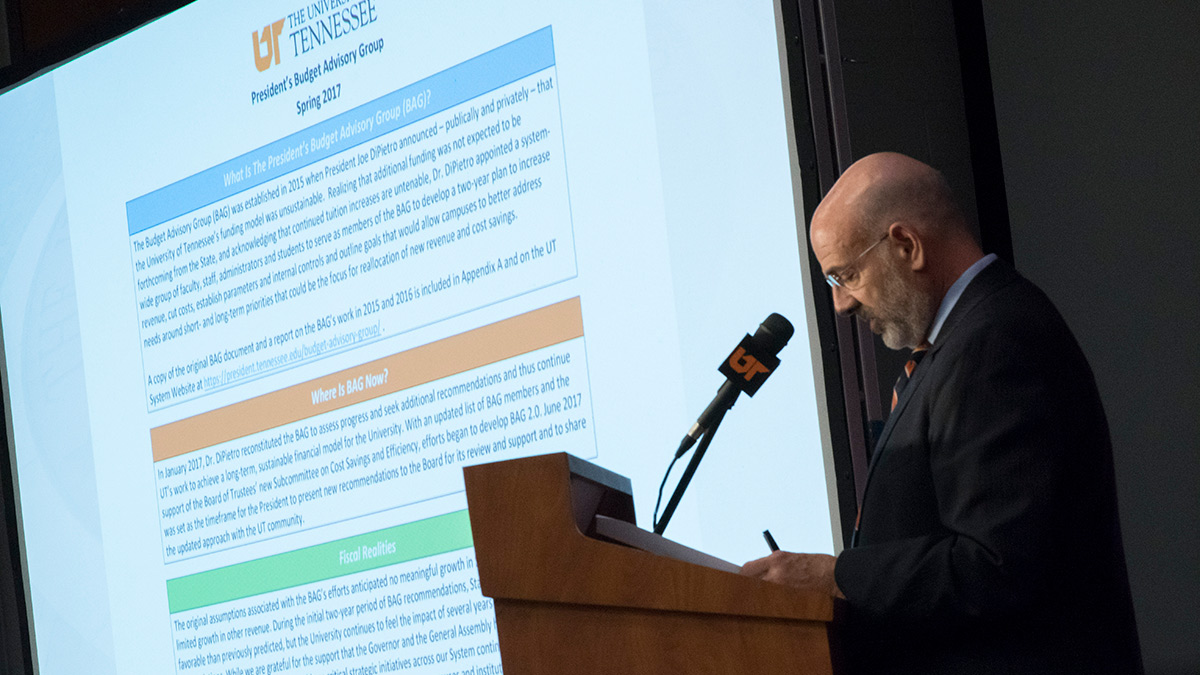
KNOXVILLE – A projected University of Tennessee funding gap has been cut from $377 million to $122 million, President Joe DiPietro told UT trustees, but more work needs to be done.
DiPietro made the announcement during the meeting of the UT Board of Trustees Thursday.
DiPietro established his “Budget Advisory Group” of internal and external advisors in 2015, after learning the University faced a then-projected $377 million shortfall by 2025. DiPietro said he would not close that gap through excessive tuition increases or pass the problem on to future university leaders.
“By being proactive to meet projected shortfalls, we will not put that burden on our students and their families,” DiPietro said. “All of these efforts are because we want to help our students on to better futures. We know that a higher education helps provide this.”
The Budget Advisory Group, or BAG, set budget boundaries and looked for other ways to cut costs and reallocate funds across the UT system all while holding tuition increases at record lows. On Thursday, the Board approved a 1.8 percent tuition increase, the lowest increase since 1984. It also marked the third year in a row of record low tuition increases, a first such three-year streak since the UT system was established in 1968.
After two years, and with unexpected increases in state appropriations, the projected funding gap has been lowered to $122 million.
“While this is great news, our work is not done,” DiPietro said.
Funding campus growth and addressing critical strategic initiatives continue to be challenging, DiPietro said, because the majority of new funds are restricted to specific projects. UT campuses and institutes fund only what is needed to keep up with inflation. Each new fiscal year, they begin with a gap that isn’t addressed by new state dollars. The next two years would require reallocation of $32.8 million to maintain current programs and partially fund the existing salary gap.
“We remain committed to controlling our own costs and taking responsibility for our future success with a renewed focus on strategic growth and becoming more efficient and effective in all aspects of the university,” he said.
As it has since 2015, the University will continue to plan for funding based on what DiPietro calls “the 3-3-0 model,” or assuming 3 percent inflation, 3 percent tuition increases and flat state funding.
Other goals set for 2017-2019 include:
- securing more accurate data on UT academic program costs and productivity
- reallocating System and campus funding from areas of low productivity and efficiency to strategic priorities, critical programs and other high-return opportunities.
- increasing research and sponsored program expenditures by 6 percent annually
- increasing gifts and pledges by 15 percent annually
- strengthening and streamlining System human resources operations for increased System-wide effectiveness, efficiency and cost-savings.
The University of Tennessee is a statewide system of higher education with campuses in Knoxville, Chattanooga, Martin and Memphis; the UT Space Institute in Tullahoma; the UT Institute of Agriculture with a presence in every Tennessee county; and the statewide Institute for Public Service. The UT system manages Oak Ridge National Laboratory through its UT-Battelle partnership; enrolls about 50,000 students statewide; produces about 10,000 new graduates every year; and represents more than 370,000 alumni around the world.
Contacts
Gina Staffordstafford@tennessee.edu
865-974-0741
Jennifer Sicking
jsicking@tennessee.edu
865-974-5179
